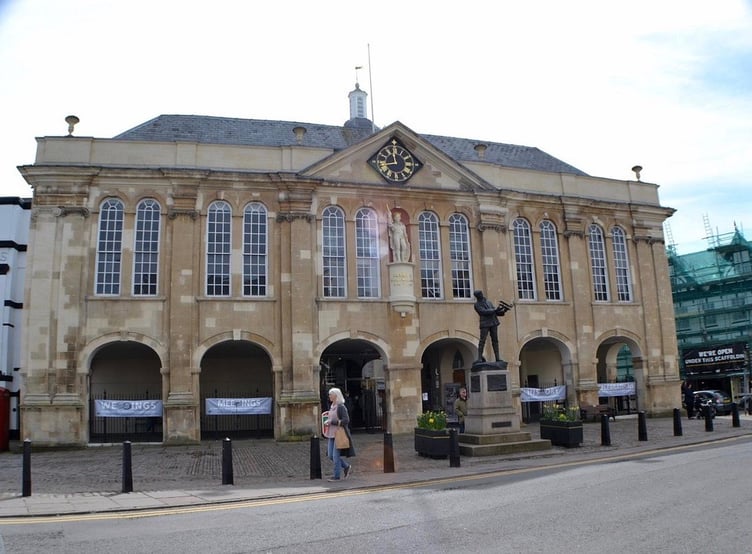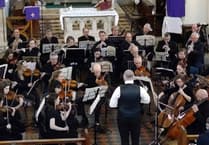IT is appropriate in this Coronation month to remember King Henry V who was born in Monmouth.
Whenever I stand in Agincourt Square, which has been given this name to commemorate the town’s most famous son, I always look up at the impressive Shire Hall to see the somewhat deformed looking effigy of Henry V standing in an arched recess on the front of this impressive building.
He looks down on the passing shoppers and appears slightly hunchbacked and is more than lifesize, for the statue is 7 feet 2 inches tall.
It was made in 1792, a few years after the 400th anniversary of his birth, by Charles Peart, a professional sculptor who had been born at nearby English Newton.
Charles Harper who wrote a guidebook to this area in 1894, was so irritated by the effigy that he commented that ‘it should be destroyed forthwith and so relieve Monmouth from the reproach of caricaturing its hero.’
The statue is certainly of poor quality and it has been variously described as ‘incongruous’, ‘rather deplorable’, ‘pathetic’ and with his right hand raised, he looks ‘like a hypochondriac inspecting his thermometer, or ‘ like he is hailing a taxi’!
The date of his birth is given below the statue as 9 August, 1387, but most historians believe that he was born on 16 September. The problem is that there is no actual record of his birth, probably because at that time it was never considered that one day Harry of Monmouth would become King of England.
It was on 25 October, 1415 (the Feast Day of St Crispin) that Henry V defeated a much larger French force at Agincourt.
It seems incredible that his army, consisting of 1,500 men-at-arms and 7,000 bowmen managed to overcome 30,000 French soldiers. We can also be proud of the fact that, it was the Welsh longbow that really won the day, for it was a fearsome weapon, once described as the ‘machine gun of the Middle Ages’.
The Welshmen, mainly from Gwent were an elite force and their rapid hail of arrows must have cut through the French chainmail like a razor through paper, with the result that Henry’s ‘band of brothers’ were able to inflict a crushing defeat on the massive French army.
The French suffered losses of between seven and ten thousand while Henry only lost five hundred men.
In 1832, the Market Square became known as Agincourt and Inch Lane was renamed Agincourt Street; more recently the town was given King Henry V Drive, Lancaster Way. Mary de Bohun Close and St Crispin’s Close.
Henry V also features in a stained glass window on the south side of St Mary’s Priory Church, Monmouth. He is shown crowned king in full armour, wearing an ermine lined cape and holding the banner of England. In the background can be seen the famous Monnow Bridge.
His birthplace, Monmouth Castle, is not seen by most visitors to the town, for it is concealed at the top of a lane leading up to Castle Hill, which is above the main shopping street, but not far from Agincourt Square.
Only a few fragments of the 12th century Great Tower and 13th century hall, now remain, but it was once an important castle, founded between 1066 and 1069 by William FitzOsbern, 1st Earl of Hereford.
It was originally an earth and timber fortress which was listed in the Domesday Book and stonework was added before 1150. The outer bailey reached down to the spot now called Agincourt Square which at one time was used as a market place.
In the fourteenth century the castle came into the possession of the House of Lancaster through the marriage of John of Gaunt (Henry V’s grandfather) to Blanche, who was heiress to the estate. The castle became one of the favourite residences of both John and his son, Henry Bolingbroke, who later became Henry IV.
Prince Henry was born to Bolingbroke’s first wife 17-year-old Mary de Bohun in a room in the Queen’s Chamber, a part of the castle which, with the castle gatehouse, had been restored by John of Gaunt in 1370.
Young Harry of Monmouth, as he was once known, was brought up at Courtfield Manor, to the east of Monmouth, near Goodrich and his nurse was a local lady called Johanna Waring, to whom, when he became King, he granted an annuity of £20.
His mother died of fever in July, 1394 at the age of 24, when Henry was just seven. He was created Prince of Wales on the same day as his father’s coronation as Henry IV and was given his grandfather’s (John of Gaunt) title of Duke of Lancaster in November 1399.
Following the death of Henry IV in 1413, Prince Henry became King Henry V at the age of 25 and his coronation took place in Westminster Abbey, the following month. He then decided to pursue his Plantagenet dynasty’s claim to the French throne and this resulted in the Battle of Agincourt
Five years after Agincourt, Henry was acknowledged by the Treaty of Troyes (1420) to be heir to the throne of France, but within a year, at the age of 34. he died in France of dysentery. His body was brought from Paris to London and interred in Westminster Abbey.
The 500th anniversary of Henry’s birth coincided in 1887 with the Golden Jubilee of Queen Victoria and the 50th anniversary of the local newspaper ‘The Monmouthshire Beacon’.
The celebrations were advertised for the 9th of August, the accepted date of his birth at that time, and the date on the Shire Hall Statue. Special events included an ‘Open Air Ball on Chippenham Mead’, ‘A Grand Display of Fireworks’ and ‘A Grand Torchlight Procession’ through the principal streets of the town.
In 2015 Monmouth celebrated the 600th anniversary of the Battle of Agincourt with a series of 45 events organised during that year, thus marking the significant role that Henry V’s famous battle played in Welsh history.
The Royal Mint produced a limited edition of a coin to mark ‘The Day when the sky grew dark with arrows’ on 25 October 1415.
This was appropriate for the Royal Mint based in the Tower of London had been producing coins during the reign of Henry V.
The Blake Theatre in Monmouth screened a production of Shakespeare’s play ‘Henry V’ live from Stratford-upon-Avon on Wednesday 21 October, the same week as the Battle of Agincourt.
Also, on the date of the battle itself, St Crispins’s Day, Sunday 25th October, a musical event celebrating the Agincourt victory was performed at St Mary’s Priory Church.
Henry V was revered as a hero of legendary proportions in his lifetime and later immortalised by Shakespeare, he is regarded as one of the greatest of the House of Plantaganet.
However, he was not a particularly good monarch or ruler of England. He spent most of his reign in campaigning and advancing English claims for the throne of France, believing that he had a genuine right for it through his great-great grandmother.
After a brief reign of nine years he died of dysentery in 1422 , just before his 35th or 36th birthday and was succeeded by his 9 month old son Henry VI who had never met his father.
Henry V in his infancy was only in Monmouth for a very brief period and he did nothing for the town in later years, making no gifts to St Mary’s Church or granting no privileges to the town.
But even after 600 years he remains a local hero and as Shakespeare saw him, ‘The Star of England... too famous to live long... whose death exceeds all speech.’





Comments
This article has no comments yet. Be the first to leave a comment.